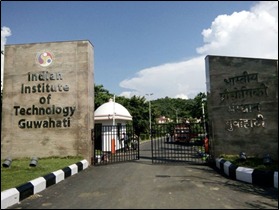IIT Guwahati Researchers make Breakthrough in Memory Architectures
IIT Guwahati Researchers have developed methods to evenly distribute accesses across the overall memory capacity to reduce the wear-out pressure on heavily written locations
GUWAHATI : Indian Institute of Technology Guwahati Researchers have made fundamental contributions to memory architectures by preventing redundancy in data values and improving slow and frequent writes in the multi-core processor systems.
When the world is rapidly moving towards research in applied areas, IIT Guwahati researchers have developed methods to solve the problems in computer systems domain. Specific contributions being in multi-core processor-based systems that need an equally large on-chip memory to commensurate the data demands of the ever-growing applications and hence preventing energy consumption to ensure the temperature remains under the thermal design power (TDP) budget.
The research is being led by Prof. Hemangee K. Kapoor, Department of Computer Science and Engineering (CSE), IIT Guwahati, and comprises a team of research scholars: Sukarn Agarwal, Palash Das, Sheel Sindhu Manohar, Arijit Nath and Khushboo Rani. The findings of their research are published in reputed peer-reviewed journals like IEEE Transactions on Computers, IEEE Transactions in VLSI, IEEE TCAD, ACM Transactions on Embedded Computing Systems, ACM TODAES, ACM JETC, to name a few. The links to some papers can be found at: https://ieeexplore.ieee.org/document/8611205 and https://dl.acm.org/doi/abs/10.1145/3411368.
Explaining the challenges of multi-core processor-based systems, Prof. Hemangee K. Kapoor, Department of CSE, IIT Guwahati said, “The application data access patterns are not uniformly distributed and hence leads to several orders of writes to certain memory locations compared to others. Such heavily written locations become prone to wear-out and thus prevents the use of complete memory device without error corrections”.
To handle this non-uniformity, IIT Guwahati researchers developed methods to evenly distribute the accesses across the overall memory capacity to reduce the wear-out pressure on heavily written locations and also worked in the area which avoids writing redundant values thus prolonging the wear-out.
Further, Prof. Hemangee K. Kapoor said, “Slow and frequent writes can be re-directed to temporary SRAM partitions sparing the NVM from getting written with such frequent accesses. Such structures are called hybrid memories”.
“The team is also working on extending them to off-chip main memory. The future challenges are to handle lifetime enhancement in presence of encryption methods used to secure the Non-volatile memory and to handle temperature and process technology driven disturbance errors introduced when the cells are read or written,” Prof. Hemangee K. Kapoor added.
The researcher’s current and future contributions will help mitigate the drawbacks of promising emerging memories and ease their adaptability. Once some drawbacks are easily removed, scientists can find newer avenues for using such technologies without worrying about its limitations.
Artificial Intelligence (AI) and Machine Learning (ML) are used as tools to solve several real-time problems. However, they involve enormous computations on huge datasets. Building close to memory accelerators to process the data are efficient in performance as well as energy. The research team is also working on building customized parallel architecture designs to give better FLOPS.
As a long-term perspective, the researchers see a trend towards edge computing leading to skyrocketing generation of data. Data creation is also fueled by 5G networks, image processing and real-time voice processing. All these big-data applications need real-time analysis at run-time and with immediate responses. Better storage and close to memory processing is the need of the hour. Non-volatile memory are advised to be used in Internet of things (IoT) and edge devices. The longevity of non-volatile memory in such devices is crucial for their service guarantees and durability. Effective lifetime improvement methods will help improving the state-of-the art in this field which is still in its nascent stage. Solutions for better management of NVMs will give them wider acceptance in critical applications including healthcare and autonomous vehicles.
###
ABOUT IIT GUWAHATI
Indian Institute of Technology (IIT) Guwahati established in 1994 has completed 25 years of glorious existence in 2019. At present, the Institute has eleven departments, five inter-disciplinary academic centres and four schools covering all the major engineering, science and humanities disciplines, offering BTech, BDes, MA, MDes, MTech, MSc and PhD programmes. The institute offers a residential campus to 412 faculty members and more than 6,000 students at present. Besides its laurels in teaching and research, IIT Guwahati has been able to fulfil the aspirations of people of the North East region to a great extent since its inception in 1994. The picturesque campus is on a sprawling 285 hectares plot on the north bank of the Brahmaputra, around 20 kms from the heart of the Guwahati city.
IIT Guwahati is the only academic institution in India that occupied a place among the top 100 world universities – under 50 years of age – ranked by the London-based Times Higher Education (THE) in the year 2014 and continues to maintain its superior position even today in various International Rankings. IIT Guwahati gained rank 41 globally in the ‘Research Citations per Faculty’ category and overall 395 rank in the QS World University Rankings 2022 released recently. IIT Guwahati has retained the 7th position among the best engineering institutions of the country in the ‘India Rankings 2019’ declared by National Institutional Ranking Framework (NIRF) of the Union ministry of Human Resource Development (HRD). IIT Guwahati has been also ranked 2nd in the ‘Swachhata Ranking’ conducted by the Govt. of India. Recently, IIT Guwahati has been ranked as the top ranked University in 2019 for IT developers by HackerRank in the Asia-Pacific region.
Among other frontier areas of research and innovation, IIT Guwahati is working towards augmenting critical science research initiatives in Genomics, Developmental Biology, Health Care and Bioinformatics, Flexible Electronics, Advanced Functional Materials, Sustainable Polymers, Rural Technologies, Disaster Resilience and Risk Reduction, and Water Resources and Management. In its silver jubilee year, IIT Guwahati is poised to scale newer heights through all round growth and development.

